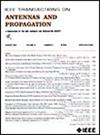Independent Control of Multiple Harmonic Beams in Time-Modulated Arrays With Subarrayed Time-Segmented Pseudorandom Modulation
IF 5.8
1区 计算机科学
Q1 ENGINEERING, ELECTRICAL & ELECTRONIC
引用次数: 0
Abstract
The inherent multiharmonic characteristics of time-modulated antenna arrays (TMAs) offer significant potential for generating multiple beams under a single radio frequency (RF) chain. However, the amplitudes and phases at different harmonic frequencies are often mutually affected, which poses challenges for independent control of multiple harmonic beams. To address this issue, this article introduces a novel multibeam TMA with subarrayed time-segmented pseudorandom modulation (STPM). By dividing the ideal continuously varied modulating waveforms into multiple time segments and approximating these time-segmented waveforms with pseudorandom modulation, the proposed STPM enables subarrays to achieve accurate amplitude-phase weightings at different harmonics. Multibeam radiation in this case could be obtained by the superposition of the harmonic beams of different subarrays. Benefiting from the low-sideband property inherited from pseudorandom modulation, the proposed SPTM effectively reduces the amplitude-phase dependence among different harmonics. A multibeam pattern synthesis strategy is then developed to analytically determine the instantaneous modulation statuses of antenna elements for specified beam-scanning angles and sidelobe levels (SLLs). Compared with state-of-the-art TMAs, the presented TMA facilitates high-precision, real-time, and independent multibeam control with a significantly reduced number of modulation statuses in time modulation modules.子阵分时段伪随机调制时调阵列中多谐波波束的独立控制
时间调制天线阵列(tma)固有的多谐波特性为在单个射频(RF)链下产生多波束提供了巨大的潜力。然而,不同谐波频率的幅值和相位往往相互影响,这给多谐波光束的独立控制带来了挑战。为了解决这一问题,本文介绍了一种新型的子阵列分段伪随机调制(STPM)多波束TMA。通过将理想的连续变化调制波形划分为多个时间段,并使用伪随机调制近似这些时间段波形,所提出的STPM使子阵列能够在不同谐波下实现精确的幅相加权。在这种情况下,可以通过叠加不同子阵列的谐波光束来获得多波束辐射。利用伪随机调制的低边带特性,有效地降低了不同谐波间的幅相依赖性。然后,开发了一种多波束方向图合成策略,以分析确定特定波束扫描角度和旁瓣电平(SLLs)下天线单元的瞬时调制状态。与最先进的TMA相比,本文提出的TMA有助于高精度、实时和独立的多波束控制,并显著减少了时间调制模块中的调制状态数量。
本文章由计算机程序翻译,如有差异,请以英文原文为准。
求助全文
约1分钟内获得全文
求助全文
来源期刊
CiteScore
10.40
自引率
28.10%
发文量
968
审稿时长
4.7 months
期刊介绍:
IEEE Transactions on Antennas and Propagation includes theoretical and experimental advances in antennas, including design and development, and in the propagation of electromagnetic waves, including scattering, diffraction, and interaction with continuous media; and applications pertaining to antennas and propagation, such as remote sensing, applied optics, and millimeter and submillimeter wave techniques

 求助内容:
求助内容: 应助结果提醒方式:
应助结果提醒方式:


